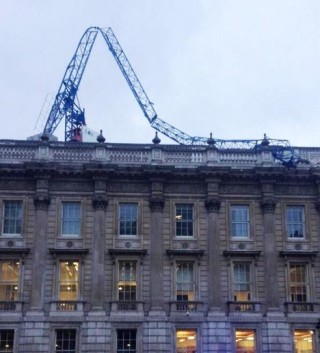And the Health & Safety Executive is supporting it.
Last month the luffing jib of a German-designed Jost JTL 158 collapsed on a Croydon building site during a storm.
In October a Jost JTL 158 luffing jib crashed onto the roof of the Cabinet Office building in central London on 28th October 2013 (pictured below). On the same day another crane of the same make and model collapsed on a site in the Old Kent Road, having already previously failed the April before.
In December 2011 a Jost crane broke on a site in Safron Walden.
In each case the crane owner was different but the failure point in the jib was the same.
The manufacturer has investigated the failures and declared itself free of blame, saying that in each case the operator had failed to leave the slewing brake off when out of service. Cranes are designed to ‘weather vane’, or rotate freely in the wind, when not in use, to minimise wind pressure on them. Keep the brake on and they are liable to snap in strong winds, especially when designed to fine tolerances.

“All the structural calculations are good. We have enough safety factor in the jib if the crane is operated correctly,” the manufacturer told International Cranes & Specialized Transport magazine.
Apparently confirming that each collapse was caused by operator error, the Health & Safety Executive (HSE) has today issued a safety bulletin to remind tower cranes operators to leave slew brakes off before they get out of the cab.
The bulletin says: “HSE has identified that some tower crane users have not been releasing the slew brake and/or placing the jib at the correct out of service radius, when leaving cranes out of service and unattended.
“If luffing jib cranes are left out of service with the slew brake engaged and/or the jib parked at too small a radius, there is a possibility the crane may not be able to weathervane freely in high winds. This could result in very high loadings being placed on the crane with the consequential collapse of the jib or the whole crane.”
However, Jost Cranes does acknowledge that it would be a good idea for crane manufacturers to adopt the use of an automatic interlock system that prevents cranes being left with the slew brake locked. “We want to see this implemented on all tower cranes of all types from all manufacturers,” Jost said.
Once again, however, the HSE is reluctant to itself suggest such simple design improvements or to offer any safety guidance to equipment manufacturers.
Earlier this month the HSE issued a safety notice advising owners of access platforms to check their machines were calibrated properly. Access platform hire company Kimberly Access said that it would be a good idea for manufacturers to modify their designs to eliminate the risk of human error in calibration.
Got a story? Email news@theconstructionindex.co.uk
.png)



